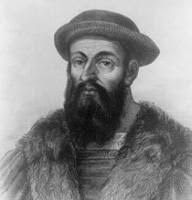
Durate Barbosa
This small essay describes Borneo before 1518 from the point of view of the Portuguese. This was after the Brunei incursion into Santubong in ~1512.
The Isles of Borneo
“Further on towards China, from the Island of Solor (Sulu) there is another island as well furnished with victuals, inhabited by heathen with a heathen King and a language of its own. A great store of edible camphor was found there, greatly esteemed by the Indians and worth its weight in silver. They carry it in cane tubes to Narsyngua,(empire in south India) Malabar(kingdom in southwest India) and Daquem(administrative center for the Vijayanagara Empire in India). This island is called Borneo”
Notes from The Book of Durate Barbosa by the Academy of Science.
1. Solor refers to the Sulu Archipelago, not the island of Sulu. It refers to the chain of islands between Mindano and Borneo, but it also includes the northeastern part of the island.
2. “Bornei where the camphor grows” by Ramusio (Giovanni Battista Ramusio 1485-1557 an Italian travel writer). For centuries, Borneo has been known to traders from China, Siam, and other countries. Po’ni was an unidentified port on the Gulf of Siam now thought to be Santubong. The Chinese in 860 mention the name.
3. The first recorded visit of Europeans to the coast of Borneo was that of the Victoria and Trinidad which made their way zither from Sebu (Cebu) after the death of Magalhaes. (Magellan). They skirted the coast from the north until they hit the town of Brunei.
4. There seems to be no Portuguese visit before 1530.
5. Governor Nuno da Cunha (Governor of Portuguese India) ordered Guncalo Pereira to Ternate from Malacca to open up trade. He visited the capitol of Brunei which Castanheda (Portuguese historian) calls Borneo. Castanheda mentions five principal cities along the coast: Modura,(?) Cerava,(Santubong) Lave,(means the sea) Tanjapura (Tamil name from India) and Borneo. (Brunei)
6. Camphor is alluded to in all accounts of Borneo. Garcia da Orta (physician and traveller who lived in India) tells of camphor from Borneo in his book Colóquios dos simples e drogas da India, published in 1563. The latter stated one pound of Borneo camphor is worth as much as a quintal(100 pounds)of camphor from China. Jan Huyghen van Linshoten(played a crucial role in opening trade with Asia and Portugal.) who stated in his book Itinerario: Voyage ofte Schipper van Jan Huyghen van Linschoten.. that “this isle is full of trees from which camphor is taken.
7. The account that Malayan camphor is distinct from Chinese Camphor is given by John Crawfurd in his book History of the Indian Archipelago 1820 ” It is the product of a large tree and not of shrub as it is in China, Japan and Formosa.”
The Book of Durate Barbosa by Durate Barbosa was written in 1518 and translated from Portuguese in 1812 by Mansel Longworth Dames of the Indian Civil Service for the Royal Academy of Sciences Lisbon London: The Hakluyt Society, 1918
BorneoHistory.net
Many thanks to Veronica Chang-Schmid
